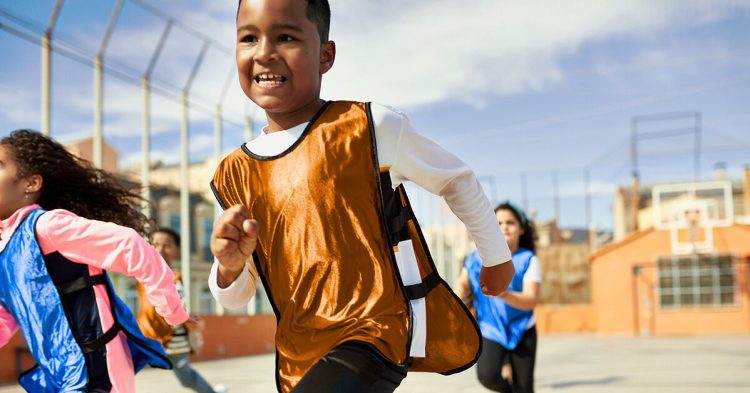It’s not too early to teach social and emotional skills for development and learning. Even infants can benefit from encouraging sharing and caring.
Prosocial behavior is defined as voluntary action intended to benefit another. In other words, it’s all those helping, sharing, and caring lessons you learned from your teachers and caregivers.
Some call these “friendship skills” or “people skills” because they’re things people do to get along.
Development of prosocial behavior
Research shows that babies show a wide range of prosocial behaviors, such as helping, sharing, and cooperating, in their first years of life.
Children show signs of helping, such as handing a toy to someone, as early as the age of 14 months. They learn these prosocial behaviors by watching their parents and other caregivers.
A 2018 study found that when 16-month-olds observed adults being helpful, the tots were likelier to be helpful.
Over time, prosocial behaviors become more sophisticated and socially necessary as children develop:
- cognitively
- socially
- language
- motor abilities
You might think of empathy and sympathy as personality traits rather than behaviors or skills. But in childhood development terms, they’re considered social and emotional skills or prosocial skills children need to learn, rather than something they’re born with.
Prosocial skills include:
Children who are socially and emotionally healthy can:
- adapt to playground politics
- ask to join ongoing play and group activities
- care and show interest in others
- develop close relationships with:
- express wishes and preferences clearly
- play and compromise with others
- recognize, label, and manage their emotions (emotional regulation)
- listen and follow directions
- show empathy
- show remorse
- take turns
- understand others’ emotions
Just as with physical health, children’s social and emotional health affects their overall development and learning. It can impact:
- ability to follow directions
- academic performance
- attitude
- emotional state
- motivation
- participation in class and activities
Research shows that prosocial behavior may enhance executive functioning (mental skills). It’s also associated with increased:
- conceptual understanding
- problem-solving
- greater academic performance (grades and test scores)
Prosocial behaviors in young children are also essential for developing healthy life and relationship skills, such as:
- avoiding negative interactions
- building and maintaining positive relationships
- cooperation
- collaboration
- emotional intelligence (EQ)
- harmony
- social cohesion
Parents, teachers, and other caregivers can help foster prosocial behavior in young children.
Research from 2018 shows that school-based and family-based interventions are successful in improving prosocial behavior in kids. Interventions include modeling appropriate social and emotional behavior, as well as engaging children in activities that teach these skills.
The above research demonstrates that when parents are warm and sensitive toward their young children, they promote empathy and prosocial behavior. The study also shows that parents support prosocial behavior through encouragement (but not material rewards).
At home
1. Dive into a book
Even infants can pick up on prosocial cues that come from reading a bedtime story together. You can point out the acts of kindness or collaboration the characters are engaged in.
As your child gets older, try asking questions, such as:
- “Why do you think he did that?”
- “How do you think she feels?”
- “What would you do if you were in this situation?”
2. Think out loud
Your child can also benefit from your thinking process. When you share aloud, it helps your child understand how you deal with emotions or solve problems.
For example: “Oops, I put two cups of flour in the cake batter instead of one. I better throw this out and start over, so the recipe comes out just right.”
3. Join in the effort
As kids get to the age where they can pitch in with chores like sweeping, tidying, and folding laundry, consider doing them together. This teaches cooperation and collaboration — and makes it more fun.
In social settings
Navigating certain social and emotional situations may seem almost instinctive to an adult, but for a child, it can take practice to become a habit.
4. Imagine and practice
You can have your child imagine certain scenarios that might come up outside the home, such as two children who want to play with the same toy at day care. You might discuss or practice various ways to handle the situation.
You could even label the behaviors as you rehearse, for example:
- problem-solving
- showing empathy
- taking turns
5. Point out prosocial behavior
There are plenty of opportunities to catch others being “prosocial” out in the world. Next time you notice, try pointing it out to your child.
For example:
- “It was so nice how that family held the door for us.”
- “I like the kind way your friend invited you to join their group.”
In the classroom
6. Act it out
Consider a puppet show for social and emotional learning. Puppets are a solid visual way to teach children how to label and express emotions (e.g., “he’s feeling lonely,” “she’s excited”).
They can also help kids practice communication by talking with the puppet or finding solutions to challenges, such as how best to put away toys together.
7. Catch them in the act
Kids need feedback to know what’s appropriate and what’s not. Try to catch them in the act when they’re problem-solving or being kind to a classmate. Label the act, and offer words of praise, such as “I like how you helped your friend by carrying her backpack.”
8. Let them catch you in the act
One of the best ways to promote prosocial behavior is by modeling or demonstrating the behavior.
For group entry, you can ask the child to join in on an ongoing game or conversation. For problem-solving or sharing, try talking with another teacher within earshot of the kids about how you’re going to share classroom supplies.
To help children develop feeling words, try labeling your emotions, for example:
- “Scary? No, I find it thrilling to jump in the deep end of the pool without floaties!”
- “I feel badly she broke her arm. I wonder how we could help her.”
Prosocial behavior is important for children’s overall development and learning. Children can learn social and emotional skills from the time they’re babies. These include helping, sharing, comforting, and cooperating.
Prosocial behavior is important for developing healthy life and relationship skills and has been shown to enhance mental functioning and improve academic performance in children.
Parents, caregivers, and teachers can help promote prosocial behaviors in children through modeling and other activities that focus on social and emotional health. These include reading together, doing joint chores, thinking out loud, role-playing with puppets, and using on-the-spot praise and encouragement.
Source by psychcentral.com


